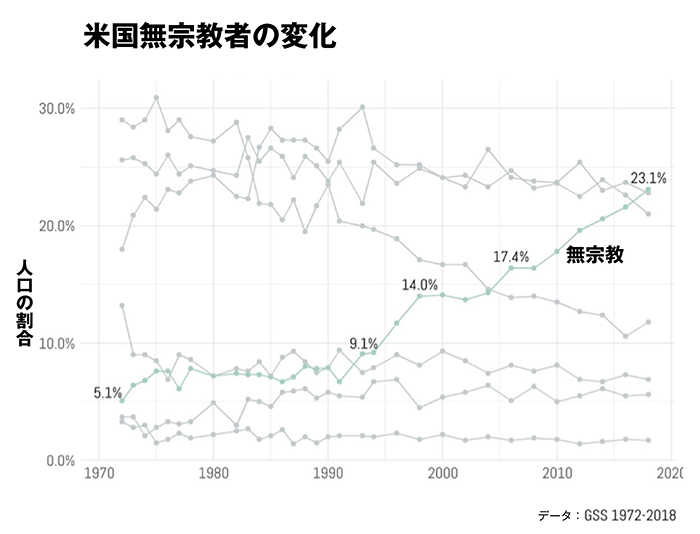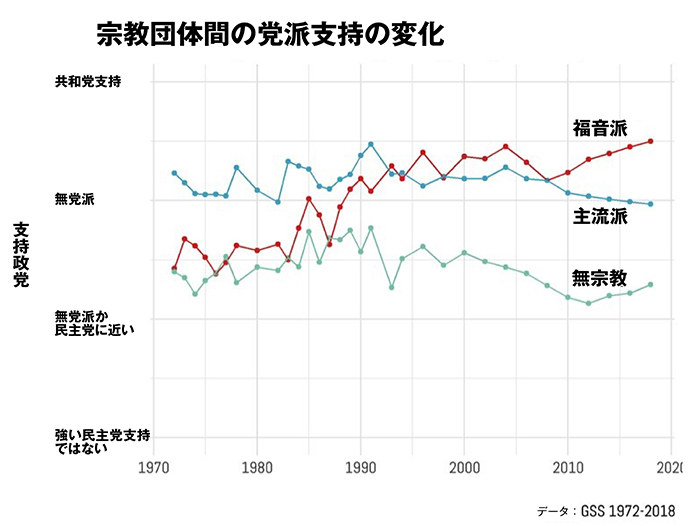無宗教のグラフの線は、ドラマチックな成長直線を描いている。1972年には、GSSの回答者の20人に1人の割合だったが、93年と98年に大きくパーセンテージを伸ばし、最後の10年間の2年ごとの調査結果を見ると、平均1~1・5%増え続けている。
The unaffiliated have had a much more dramatic trajectory, starting at just 1 in 20 of GSS respondents back in 1972. The nones experienced big jumps in 1993 and 1998, and have added, on average, 1-1.5 percentage points every 2 years for the last 10 years.

無宗教者の継続的な成長については以前、記事となっており、今回の調査結果は当時すでに予想されていた。2018年の大きな発見は、「無宗教」の人々は現在、米国の福音派と同じくらい一般的であり、どちらも人口の約23%を占めていることだ。
Their continued growth has been well-documented and at this point, expected. The big finding in 2018 is that those of “no religion” are now as common as evangelicals in the US, both about 23 percent of the population.
この時点では、これらのグループ間の統計的な違いは有意ではない。しかし、無宗教が近いうちに横ばいになると考える理由は見つからない。福音派が停滞している間も無宗教が成長を維持するなら、5年以内に無宗教がいちばん大きなグループになることは統計的に避けられない。
The difference between these groups is not statistically at this point; but I see no reason to think that the nones will level off anytime soon. If the nones maintain their growth while evangelicals stagnate, it is statistically inevitable that those of no religious faith will be the largest group in America in the next five years.

昨年はまた、主流派のクリスチャンの数がわずかに増加した。これは、20年近くで初めての増加だ。
Last year also brought a small uptick in the number of people who identify as mainline Protestants—their first increase in nearly 20 years.
主流派には、合同メソジスト教会、米国聖公会、米国バプテスト同盟が含まれる。1972年の30%から、2016年にはたった10%へと、過去40年間で大幅な減少となっていたが、18年には11・8%に急増した。
Mainline Protestants include those who identify as United Methodists, Episcopalians, or American Baptists. They have suffered tremendous declines over the last 40 years, going from 30 percent of the population in 1972 to just 10 percent in 2016. But in 2018, that share bumped to 11.8 percent.
1年間の増加から、それ以上のことを推定するのは賢明ではない。しかし、ドナルド・トランプが大統領になったことで、穏健なクリスチャンが福音派を離れ、主流派に転会した結果かもしれない。2016~18年の間に福音派は1・4%減少し、主流派にはわずかな増加があった。「福音派の損失が主流派の益となった」と言うには時期尚早(しょうそう)だが、この傾向が今後2年間続くか加速するのであれば、「トランプが原因で福音派から離脱した者があった」という主張にある程度の信憑性(しんぴょうせい)を与えるだろう。
It would unwise to extrapolate too much from a single-year increase. However, it may be the result of some moderate Protestants leaving evangelicalism for mainline denominations over Donald Trump’s presidency. Evangelicals declined 1.4 percent between 2016 and 2018, while mainline Protestants saw a slight increase. It is too early to say that these evangelical losses were mainline gains; however, if this trend continues or possibly accelerates in the next two years, it would give some credence to the claim that Trump has led to evangelical defections.
主流派が政治的に左翼に向かい続けているのに対し、福音派は右翼へのシフトを維持していることが、GSSの調査から分かる。この継続的な分極化は、自らの政治的な世界観を分かち合える教会を探すため、より穏健な福音派へと導くかもしれない。(トランプの選挙後に行われた他の調査では、ヒラリー・クリントンに投票した福音派やボーンアゲイン・クリスチャンが、2011~17年の間にクリスチャンをやめたり、教会に出席しなくなったりした可能性が高い)
The GSS also shows that mainline Protestants have continued to move toward the left of the political spectrum, while evangelicals maintain their shift to the right. This continuing polarization may lead more moderate evangelicals to seek out a church that shares their political worldview. (Other surveys conducted after Trump’s election found that evangelical or born-again Christians who voted for Hillary Clinton were more likely to drop the label or see church attendance slide between 2011 and 2017.)
この傾向は今後のGSSの調査で注視する必要がある。
This trend will need to be monitored in upcoming waves of the GSS.
執筆者のライアン・P・バージは、イースタン・イリノイ大学の政治学の講師。彼の研究は「公共の場の宗教」のホームページに掲載されている。
本記事は「クリスチャニティー・トゥデイ」(米国)より翻訳、転載しました。翻訳にあたって、多少の省略をしています。
出典URL:https://www.christianitytoday.com/news/2019/march/evangelical-nones-mainline-us-general-social-survey-gss.html
「クリスチャニティー・トゥデイ」(Christianity Today)は、1956年に伝道者ビリー・グラハムと編集長カール・ヘンリーにより創刊された、クリスチャンのための定期刊行物。96年、ウェブサイトが開設されて記事掲載が始められた。雑誌は今、500万以上のクリスチャン指導者に毎月届けられ、オンラインの購読者は1000万に上る。
関連



























